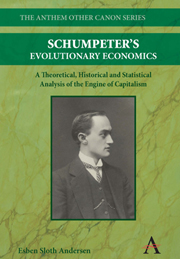 Schumpeter's Evolutionary Economics
Schumpeter's Evolutionary Economics Book contents
- Frontmatter
- Contents
- List of Figures
- List of Tables
- Preface
- Acknowledgements
- Abbreviations
- 1 Introduction
- I Equilibrium Economics and Evolutionary Economics
- II The Evolutionary Trilogy
- III Works in Progress
- Appendices
- A Chronology
- B Literature on Schumpeter
- C Accessing and Grouping Schumpeter's Works
- D Some Tools for Evolutionary Analysis
- Schumpeter's Works
- Other References
- Index of Schumpeter's Works
- Index of Persons
D - Some Tools for Evolutionary Analysis
from Appendices
Published online by Cambridge University Press: 05 March 2012
- Frontmatter
- Contents
- List of Figures
- List of Tables
- Preface
- Acknowledgements
- Abbreviations
- 1 Introduction
- I Equilibrium Economics and Evolutionary Economics
- II The Evolutionary Trilogy
- III Works in Progress
- Appendices
- A Chronology
- B Literature on Schumpeter
- C Accessing and Grouping Schumpeter's Works
- D Some Tools for Evolutionary Analysis
- Schumpeter's Works
- Other References
- Index of Schumpeter's Works
- Index of Persons
Summary
The present appendix deals with some of the analytical problems that Schumpeter faced in his treatment of the evolutionary processes that take place between and within ‘industries’. The suggested solutions are treated under the headings the ecological approach (Section D.1) and the statistical approach (Section D.2). Although these solutions do not include economic variables like profit and credit, they can nevertheless be classified as relating to, respectively, evolutionary mesoeconomics and evolutionary microeconomics (Dopfer and Potts, 2008). The theoretical, historical, and statistical analysis of the capitalist engine requires a lot of other analytical tools. For instance, there is an obvious need of developing the tools for evolutionary macroeconomics. Furthermore, the algorithmic reconstruction of evolutionary processes and their implementation in computer simulation models have proved crucial (Nelson and Winter, 1982; Andersen, 1994). Nevertheless, a short presentation of the ecological approach and the statistical approach serves to demonstrate that formalisation can clarify existing concepts of evolutionary analysis and suggest new concepts.
The ecological approach to evolutionary analysis
Schumpeter's treatment of the process of creative destruction in the historical parts of Business Cycles (see Section 8.2) included much attention to the structure of the “industrial organism”. When we take the structure of this “organism” into account, it becomes clear that he was considering a much more complex process of creative destruction than the one covered by the reconstructions of the Mark I and Mark II models of the capitalist engine (see Section 9.5). It also becomes clear that he seriously needed analytical tools for handling this complexity.
- Type
- Chapter
- Information
- Schumpeter's Evolutionary EconomicsA Theoretical, Historical and Statistical Analysis of the Engine of Capitalism, pp. 427 - 446Publisher: Anthem PressPrint publication year: 2009


